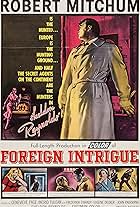PTaylor129
Joined May 2020
Welcome to the new profile
We're still working on updating some profile features. To see the badges, ratings breakdowns, and polls for this profile, please go to the previous version.
Ratings602
PTaylor129's rating
Reviews11
PTaylor129's rating
Danger Route has usually been dismissed (if not ignored) as an unexciting, confused and run-of-the mill spy thriller, not to say another unsuccessful attempt from the second half of the 1960s to cash in on the success of the James Bond series. Yet, while it is imperfect in several ways, Danger Route deserves credit for its original and intelligent plot, dark realism and fine performances. Despite its misleading promotional poster, the film does not actually try to entice the viewer with Bond-style suspense and action sequences, but rather with its complex intrigue and character study of a disillusioned secret agent operating in a world where no-one may be quite what they seem to be. Indeed, the film's style is closer to the genre more successfully represented by the likes of The Spy Who Came in from the Cold and the Harry Palmer films starring Michael Caine. Perhaps the plot lingers a little bit at the beginning and appears unnecessarily convoluted, but if one is willing to struggle through some confusion, it is quite interesting to follow and remains consistently unpredictable. It is somewhat difficult to get emotionally engaged into the story, partly because the main character, played by Richard Johnson, is rather enigmatic and distant - he is after all a cold-blooded assassin (albeit one working on "our side"). But this is arguably part of the film's originality. While there had already been a few similarly dark and cynical espionage dramas by 1967 (notably those aforementioned), it was not yet common to have such a morally ambiguous and cynical hero. This would, however, become much more the norm for this film genre in the 1970s. Richard Johnson does a fine job of conveying the detachment and weariness of this character, even subtly managing to attract some sympathy for his predicament. Johnson is surrounded by a strong cast that includes Carol Lynley, Barbara Bouchet, Gordon Jackson, Sylvia Syms, Harry Andrews, and Diana Dors, who all give very good performances. Where the film slightly fails in my view is in its uneven direction (it is known that director Seth Holm became ill during the shooting of the film) and average production values, which sometimes make it seem like a B-feature, although it is not.
Ultimately, I don't consider Danger Route to quite be a good film, but it is certainly better than your routine spy romp, and has some interesting elements going for it.
While there has by now been a host of movies on different periods of the Irish civil war/conflict, the topic had rarely been dealt with in mainstream cinema until 1959's Shake Hands With the Devil (though Odd Man Out is an important, more well-known predecessor). The film is an interesting on-location shooting of a 1933 novel by Rearden Conner, taking place against the backdrop of the Anglo-Irish conflict in the early 1920s. It provides an evocative, realistic and thoughtful rendition of this particularly tumultuous period of Ireland's history. A more recent and comprehensive historical, dramatized account of the period can be found in the film, Michael Collins, starring Liam Neeson. But for its time, Shake Hands With the Devil does a commendable job of depicting the politics surrounding the conflict, Irish society, the brutality of the British Black and Tans, and the ambiguous morals and objectives of the IRA. It is somewhat less concerned about history than in showing how a peaceful person can be drawn into an idealistic violent conflict, and how sometimes, apparently noble causes can lead to violence for its own sake. These themes are explored through two central characters, played by Don Murray, as an Irish-American medical student who initially resists taking part in the Irish liberation movement but changes when he himself falls victim to the violent methods of the Black and Tans, and James Cagney, as a hard-boiled IRA cell leader who has become obsessed with fighting and killing even when Irish self-government seems possible. Cagney's character is presumably the manifestation of the old Irish proverb that provides the story's title: "Those who shake hands with the devil often have trouble getting their hands back".
Murray, a promising leading man of the late 1950s, delivers an honest performance, appropriately conveying the self-questioning and ambivalence of his character. He is, however, overshadowed by Cagney's powerful characterization and self-assured acting. Cagney manages to make his character both sympathetic and chilling. Towards, the end, he becomes perhaps less believable when he apparently takes sadistic pleasure in killing in a typically Cagneyesque manner, which seemed to me not quite consistent with his behavior earlier and not necessary to understand his actions. In that sense, the film somewhat simplifies the motives of those in the IRA who chose to continue to fight after the Anglo-Irish Treaty of 1921 and avoids delving into the true complexities of the conflict. Still, it's a compelling and credible story, beautifully shot and expertly directed by Michael Anderson, with a good dose of action and suspense. While Dana Wynter may be a bit cold as a leading lady (and that's maybe the way she is supposed to be), there is excellent support from a string of reputed Irish and British actors, including Michael Redgrave, Glynis Johns, Cyril Cusack, Ray McAnally, Sybil Thorndike, and Richard Harris, making a strong impression in his first film role.
























